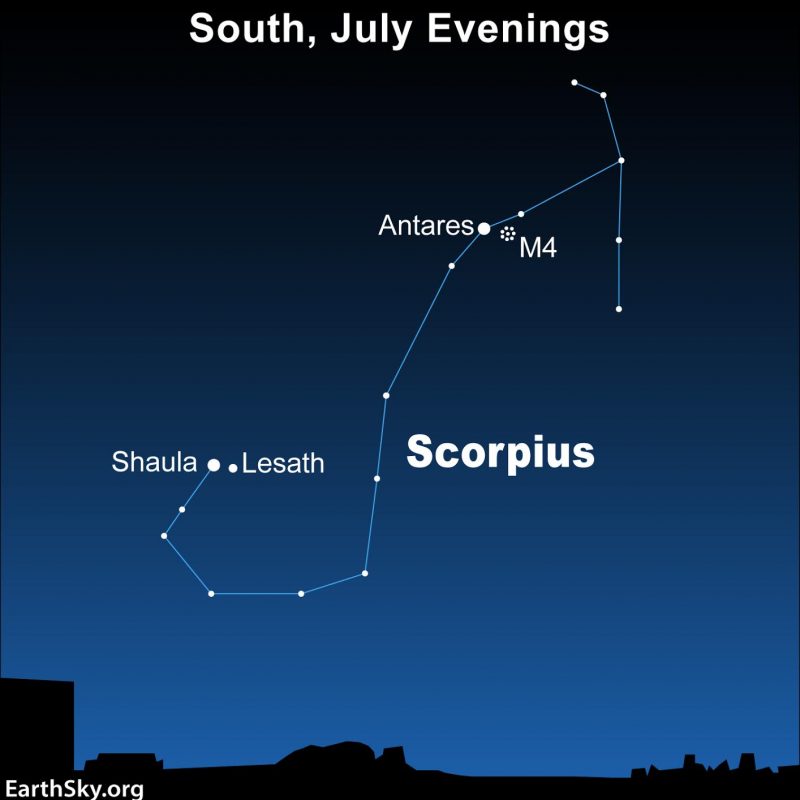
Bright red Antares is easy to find in the prominent zodiacal constellation Scorpius the Scorpion. And if you look just slightly west of it through binoculars, you’ll see a small faint diffuse ball of light. Through a moderate-sized telescope, that fuzzy ball resolves into a tight collection of faint stars suspended in the darkness. That’s Messier 4, called M4 for short. It’s a globular star cluster, an ancient member of our Milky Way galaxy. M4 shines at magnitude +5.9, so it may be visible as a smudge on the sky under very dark skies.
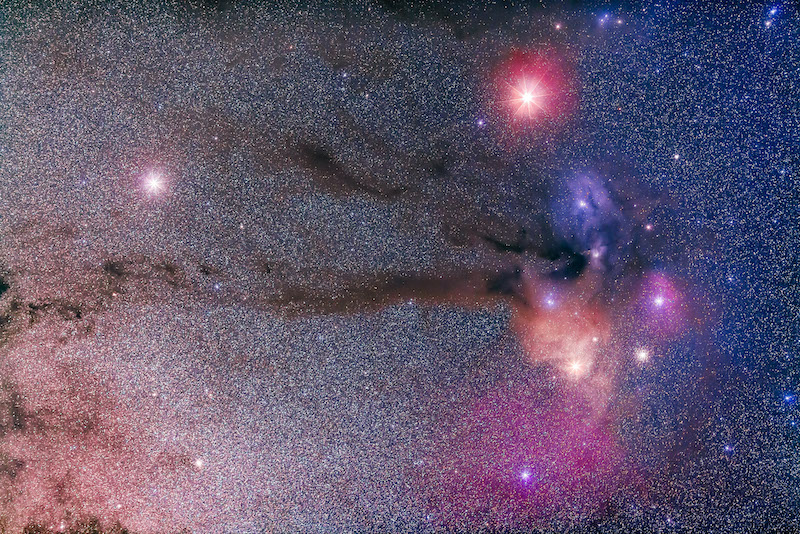
Find M4 in binoculars first
If you’ve never found a deep-sky object on your own before, M4 is a grand place to start. Northern Hemisphere summer evenings – or Southern Hemisphere winter evenings – are probably your best bet for catching M4. The M4 globular star cluster is easy to find, because it’s right next to the first-magnitude star Antares, the brightest star in the constellation Scorpius the Scorpion.
In early June, Antares is highest in the sky around midnight (1 a.m. daylight saving time). That means it’s high in the south for Northern Hemisphere viewers, and overhead for Southern Hemisphere viewers. The stars return to the same place in the sky some two hours earlier every month. So, Antares is highest up around 10 p.m. (11 p.m. daylight saving time) in early July, and 8 p.m. (9 p.m. daylight saving time) in early August.
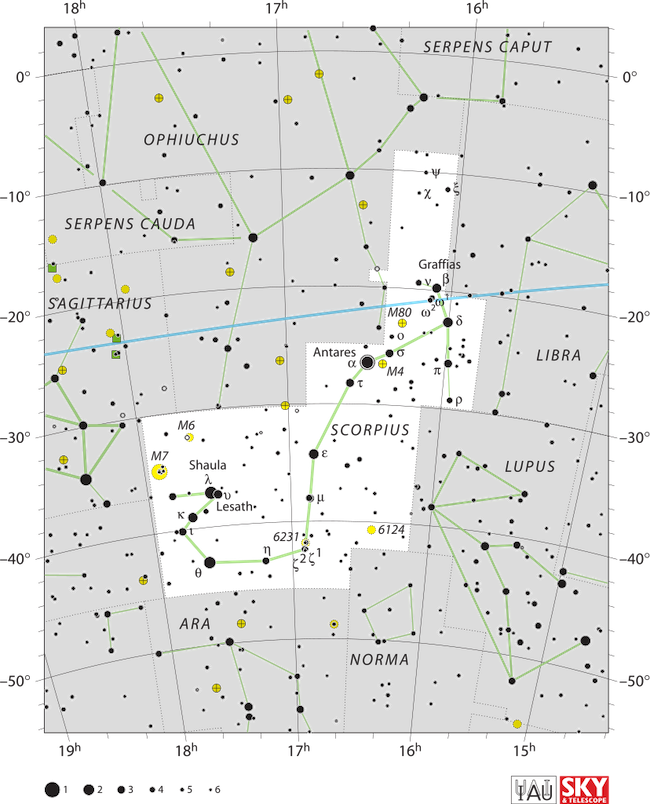
Antares and M4 readily fit inside the same binocular field of view, with M4 appearing a bit more than 1 degree to the west of Antares. For reference, a typical binocular field has a diameter of 5 to 6 degrees. M4 looks like a rather dim, hazy star in binoculars.
Once you spot it, you might begin longing for a telescope to be able to resolve this fuzzy cluster into a clump of starry pinpoints.
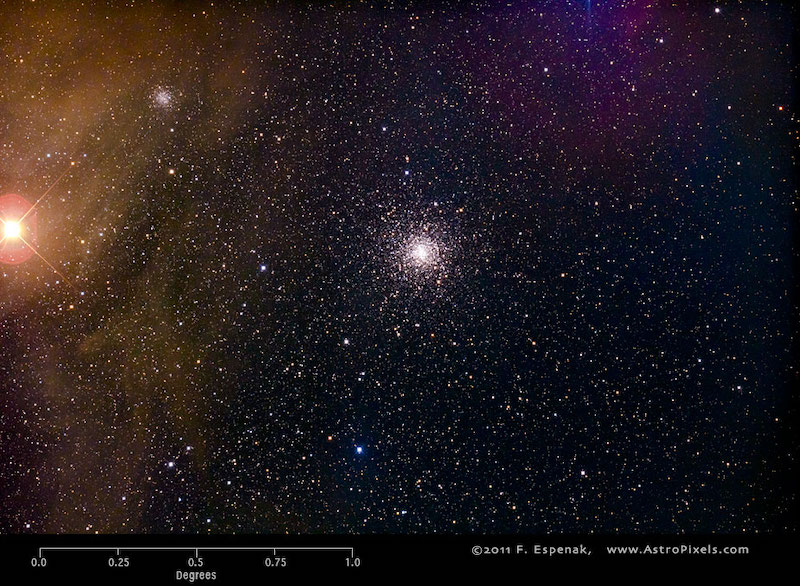
History of Messier 4
Swiss astronomer Jean-Philippe Loys de Chéseaux discovered M4 in 1746. However, it’s named after comet hunter Charles Messier (1730-1817). He listed M4 as object #4 in his famous Messier catalog. The catalog listed over 100 deep-sky objects that look like comets but really aren’t. Charles Messier wanted to steer comet hunters away from these faint fuzzies that masquerade as comets.

Science of M4
Today, we know that M4 is a globular star cluster – a globe-shape stellar city packed with perhaps a hundred thousand stars. At about 6,000 light-years from Earth, M4 is the closest globular cluster to us. In comparison, most globulars in our galaxy reside tens of thousands of light-years away. The farthest globular cluster, M54, is about 87,000 light-years in distance.
Unlike open star clusters – such as the Pleiades and the Hyades – the Milky Way galaxy’s 150 or so known globular star clusters are not part of the galactic disk. Instead, globular clusters populate the galactic halo, the sphere-shaped region of the Milky Way circling above and below the galactic disk. There are likely more globular clusters hidden from view by the Milky Way’s central bulge and by clouds of dust and gas.
Difference between globular and open clusters
Globular clusters are tightly packed with tens to hundreds of thousands of stars, whereas open clusters are loosely-bound stellar groups with only a few hundred to a thousand stars. Globular clusters contain primitive stars that are billions of years old and almost as old as the universe itself. On the other hand, open clusters consist of young, hot stars that tend to disperse after hundreds of millions of years.
If you had a telescope like Hubble, it would allow you to see these ancient stars as shown in this animation.
M4’s position is at Right Ascension: 16h 23m 35s; Declination: -26° 31′ 33″
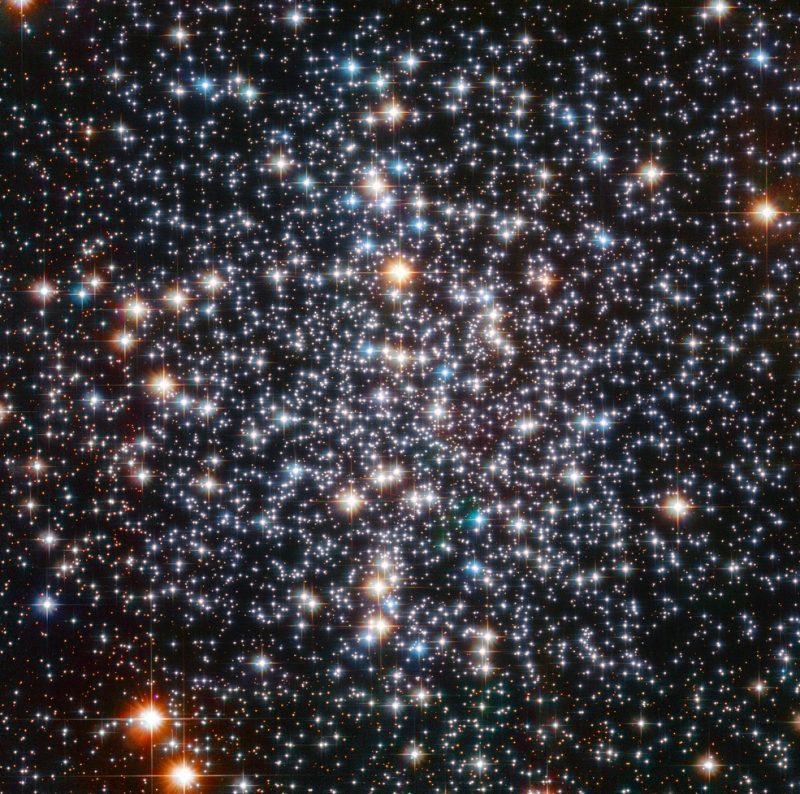
Bottom line: Find M4, one of the easiest globular star clusters for beginners to spot, located just next to reddish Antares, the brightest star in Scorpius the Scorpion.
The post Find M4: An easy to spot globular cluster near Antares first appeared on EarthSky.
from EarthSky https://ift.tt/M7n81ql

Bright red Antares is easy to find in the prominent zodiacal constellation Scorpius the Scorpion. And if you look just slightly west of it through binoculars, you’ll see a small faint diffuse ball of light. Through a moderate-sized telescope, that fuzzy ball resolves into a tight collection of faint stars suspended in the darkness. That’s Messier 4, called M4 for short. It’s a globular star cluster, an ancient member of our Milky Way galaxy. M4 shines at magnitude +5.9, so it may be visible as a smudge on the sky under very dark skies.

Find M4 in binoculars first
If you’ve never found a deep-sky object on your own before, M4 is a grand place to start. Northern Hemisphere summer evenings – or Southern Hemisphere winter evenings – are probably your best bet for catching M4. The M4 globular star cluster is easy to find, because it’s right next to the first-magnitude star Antares, the brightest star in the constellation Scorpius the Scorpion.
In early June, Antares is highest in the sky around midnight (1 a.m. daylight saving time). That means it’s high in the south for Northern Hemisphere viewers, and overhead for Southern Hemisphere viewers. The stars return to the same place in the sky some two hours earlier every month. So, Antares is highest up around 10 p.m. (11 p.m. daylight saving time) in early July, and 8 p.m. (9 p.m. daylight saving time) in early August.

Antares and M4 readily fit inside the same binocular field of view, with M4 appearing a bit more than 1 degree to the west of Antares. For reference, a typical binocular field has a diameter of 5 to 6 degrees. M4 looks like a rather dim, hazy star in binoculars.
Once you spot it, you might begin longing for a telescope to be able to resolve this fuzzy cluster into a clump of starry pinpoints.

History of Messier 4
Swiss astronomer Jean-Philippe Loys de Chéseaux discovered M4 in 1746. However, it’s named after comet hunter Charles Messier (1730-1817). He listed M4 as object #4 in his famous Messier catalog. The catalog listed over 100 deep-sky objects that look like comets but really aren’t. Charles Messier wanted to steer comet hunters away from these faint fuzzies that masquerade as comets.

Science of M4
Today, we know that M4 is a globular star cluster – a globe-shape stellar city packed with perhaps a hundred thousand stars. At about 6,000 light-years from Earth, M4 is the closest globular cluster to us. In comparison, most globulars in our galaxy reside tens of thousands of light-years away. The farthest globular cluster, M54, is about 87,000 light-years in distance.
Unlike open star clusters – such as the Pleiades and the Hyades – the Milky Way galaxy’s 150 or so known globular star clusters are not part of the galactic disk. Instead, globular clusters populate the galactic halo, the sphere-shaped region of the Milky Way circling above and below the galactic disk. There are likely more globular clusters hidden from view by the Milky Way’s central bulge and by clouds of dust and gas.
Difference between globular and open clusters
Globular clusters are tightly packed with tens to hundreds of thousands of stars, whereas open clusters are loosely-bound stellar groups with only a few hundred to a thousand stars. Globular clusters contain primitive stars that are billions of years old and almost as old as the universe itself. On the other hand, open clusters consist of young, hot stars that tend to disperse after hundreds of millions of years.
If you had a telescope like Hubble, it would allow you to see these ancient stars as shown in this animation.
M4’s position is at Right Ascension: 16h 23m 35s; Declination: -26° 31′ 33″

Bottom line: Find M4, one of the easiest globular star clusters for beginners to spot, located just next to reddish Antares, the brightest star in Scorpius the Scorpion.
The post Find M4: An easy to spot globular cluster near Antares first appeared on EarthSky.
from EarthSky https://ift.tt/M7n81ql

Aucun commentaire:
Enregistrer un commentaire